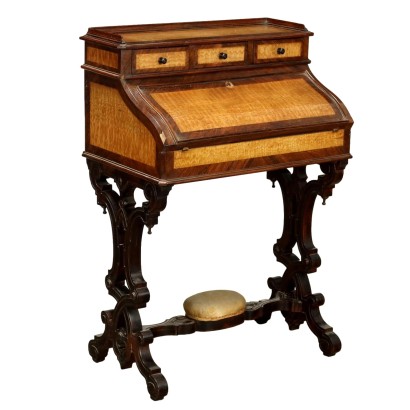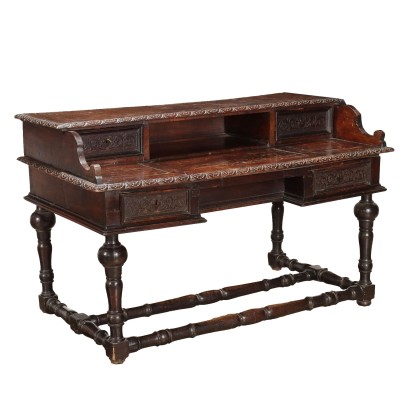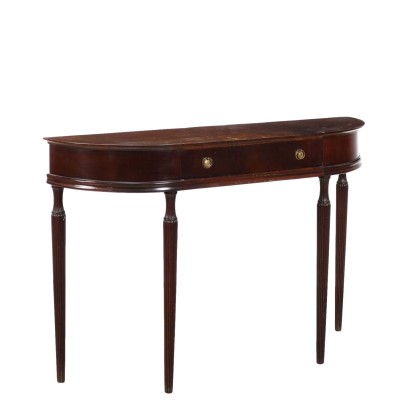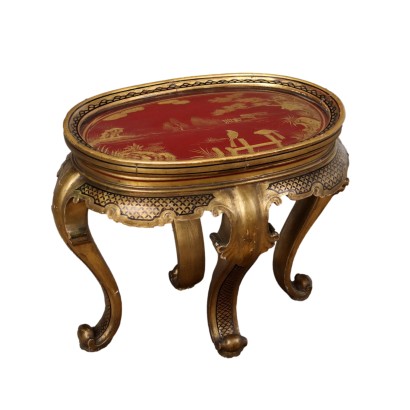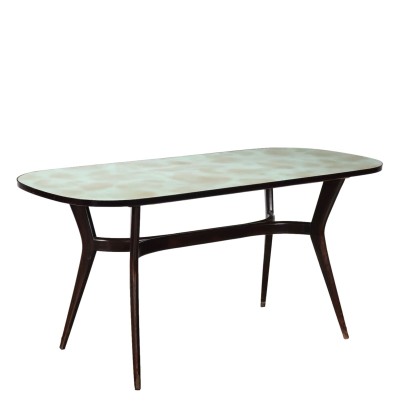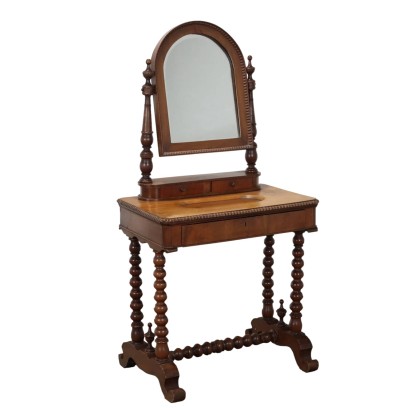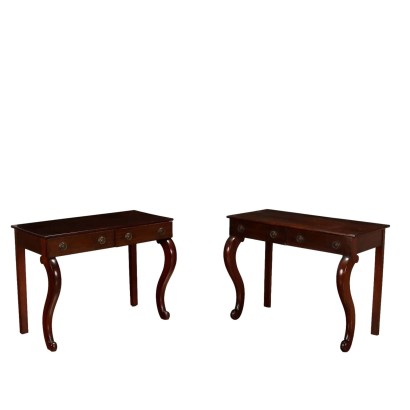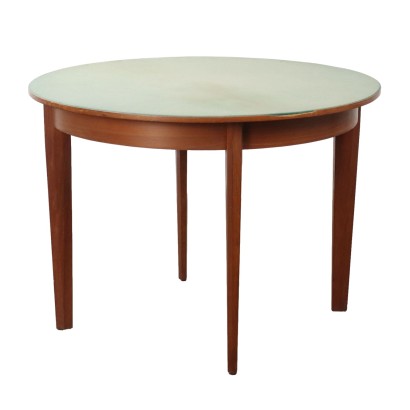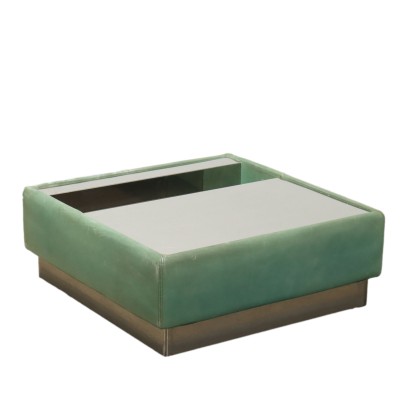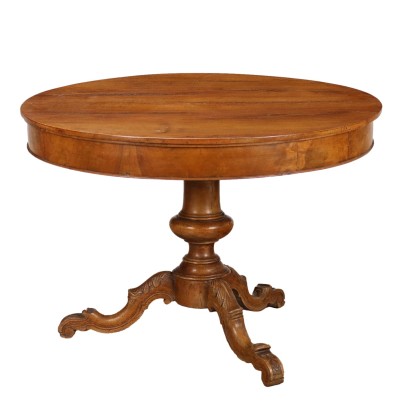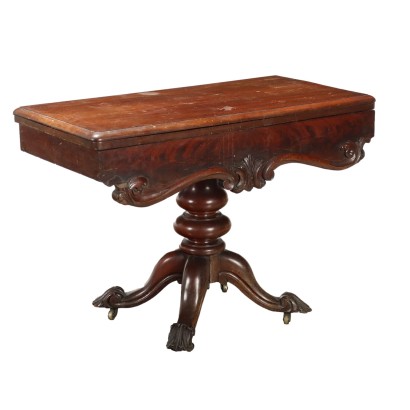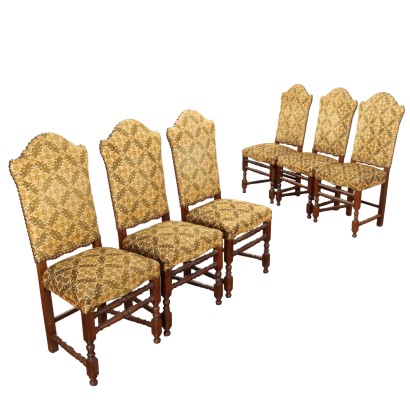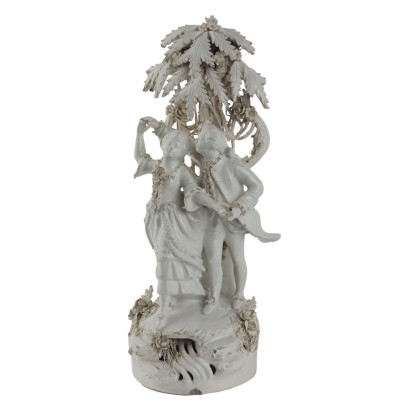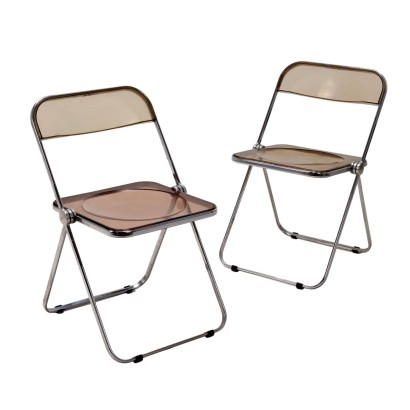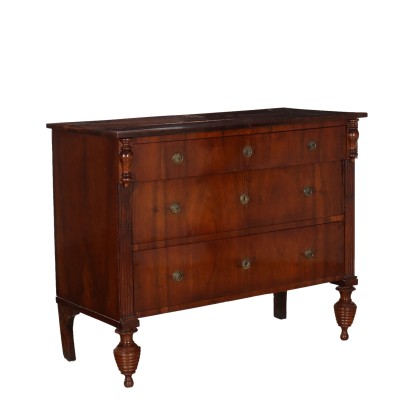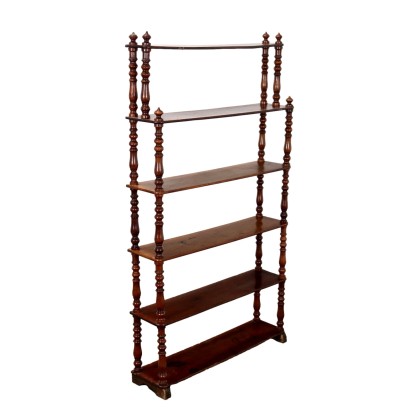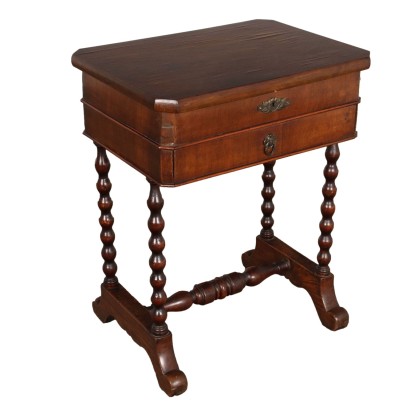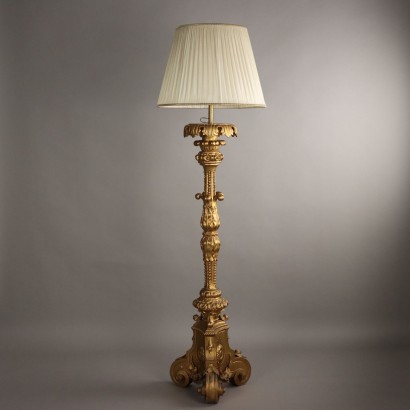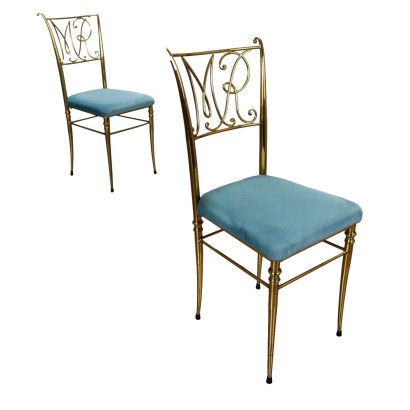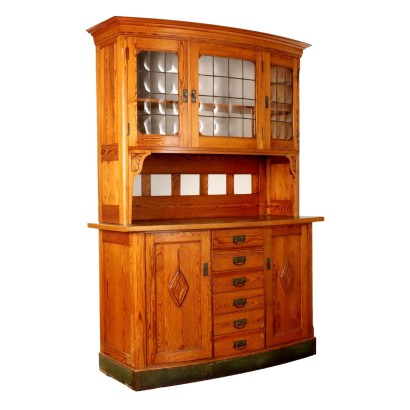Small Antique Desk Napoleon III Various Essences France XIX Century - France, Late XIX Century
Features
France, Late XIX Century
Style: Napoleon III (1848-1870)
Age: 19th Century / 1801 - 1900
Origin: France
Main essence: Maple , Brazilian Rosewood , Ash Tree , Walnut , Poplar
Material: Gilded Bronze , Padded , Walnut Veneer , Maple Burl Veneer , Painted Wood , Carved Wood , Duffle
Description
Small Napoleon III open desk with folding door, made of rosewood painted walnut, France third quarter 19th century. Upper shelf with raised railing and three drawers in the band, flap door concealing cabinet with drawers equipped with gilded bronze handles, removable secret compartment and cloth insert. The cabinet is veneered in maple briar and decorated with bois de rose borders. Carved legs embellished with reserves, curls and turned pinnacles, culminating with curled feet and connected by a crosspiece with a padded footrest. With the exception of the legs, the furniture is decorated with ash reserves. Maple and poplar interior.
Product Condition:
Product which due to age and wear requires restoration and re-polishing. We try to present the real state of the furniture as completely as possible with photos. If some details are not clear from the photos, what is stated in the description applies.
Dimensions (cm):
Height: 104,5
Width: 73
Depth: 47
Additional Information
Style: Napoleon III (1848-1870)
With Napoleon III as emperor, France experienced a period of extraordinary economic prosperity, a factor that allowed it to reconstitute a formidable war machine.In short, the dream that had once been Bonaparte's was revived: France as a great European hegemonic power.
The euphoria and grandeur also found perfect correspondence in the furnishings that characterized the Second Empire.
In Italy, the Napoleon III Style initially had insignificant effects, imposing furnishings in imitation of Louis XVI with an ornamental value resolved only in carving and completely devoid of bronze frills, in deference to a more sober taste that would always characterize Italian clients.
Only in the first decades of the twentieth century did "French" furniture find important commercial outlets in our country.
This is the name given to the artistic production of France under Napoleon III, president in 1848 and emperor from 1852 to 1870, the year of his abdication.
Rather than a style, we can speak of a set of styles, or rather revivals, given that in these years the eclectic tendency that had already appeared during the previous reign of Louis Philippe developed to its extreme consequences.
The drive to re-evaluate history and the Middle Ages also derives from the romantic spirit, as well as from the nationalistic one.
The houses were therefore furnished by mixing different styles and drawing from both the past and the East, with a tendency towards luxury and pomp that reflected the emperor's desire for grandeur.
In general, there was a return to the entire 18th century, with particular attention to Louis XVI; the fashion for dark woods (ebony and rosewood), exotic woods and bronze applications is confirmed.
From the 17th century onwards, the inlay created by André-Charles Boulle, the great cabinetmaker of Louis XIV, was revived. He created an inlay technique in gilded bronze and tortoiseshell, in which one of the two materials acts as a background for the perforated designs of the other.
Compared to the refinement of the original pieces, the "Boulle" furniture of this period is heavier and also flashier, given the addition of bright colours through painted sheets or parts in horn coloured blue, red or green.
Always in the wake of eclecticism, Venetian furniture arouses particular interest, which stimulates the production of polychrome and gilded furniture, in which figures of Moors often appear as supports.
These latter are also linked to the passion for the exotic that leads to the fashion for chinoiserie (in especially after the conquest of Beijing in 1860).
Discover more about the Napoleon III style with our insights:
a Napoleon III Secretaire to discover the cabinet with hiding places
A Napoleon III table to discover the caryatid
FineArt: Chandelier – O. Lelièvre & Susse Frères, Paris, last quarter of the 19th century
FineArt: Napoleon III Sideboard
The Austrian taste of Baroque
The Louis XV cabinet
The history of the writing desk
Napoleone III: the charm of the exotic in furniture
Age: 19th Century / 1801 - 1900
19th Century / 1801 - 1900Main essence:
Maple
Hard, light wood used for inlays. It grows mainly in Austria, but it is widespread throughout the northern hemisphere, from Japan to North America, passing through China and Europe. It is one of the lightest woods ever, tending to white, it is similar to lime or birch wood. The briar is used in the production of ancient secretaires .Brazilian Rosewood
It is a hard, light blond wood, but with strong red and pinkish veins, which is obtained from tropical trees similar to rosewood. Its veins are reminiscent of striped tulips, which is why it is called tulipwood in English-speaking areas. It is used for inlays, often combined with bois de violette. In the 1700s and 1800s it was highly appreciated and used in France and England for precious veneers. It gives off scent for decades if not centuries after curing.Ash Tree
Ash wood is divided into two types. The first, white ash, is obtained from the fraxinus indiana which grows in North America and Europe, is very elastic and resistant but subject to woodworm. It is used in the construction of furniture and more rarely as an ornament. The second type, the common ash, is obtained from the fraxinus excelsior which grows in Europe, north-western Africa and western Asia, and was used by English and American cabinetmakers to make chairs. -Walnut
Walnut wood comes from the plant whose botanical name is juglans regia , probably originally from the East but very common in Europe. Light or dark brown in color, it is a hard wood with a beautiful grain, widely used in antique furniture. It was the main essence in Italy throughout the Renaissance and later had a good diffusion in Europe, especially in England, until the advent of mahogany. It was used for solid wood furniture and sometimes carvings and inlays, its only big limitation is that it suffers a lot from woodworm. In France it was widely used more than anything else in the provinces. In the second half of the eighteenth century its use decreased significantly because mahogany and other exotic woods were preferred.Poplar
Essence considered "poor", it is a white wood, with yellowish or greyish shades, light and tender, which is easily damaged. It is used for rustic furniture or in the construction of furniture. The most valuable use it has had in the history of furniture is in Germany, in the 19th century, for veneers and inlays in the Biedermeier period.Material:
Gilded Bronze
Padded
Walnut Veneer
Maple Burl Veneer
Painted Wood
Carved Wood
Duffle
Other customers have searched:
Scrittoi, tavolo, scrivania..
Approfondimenti
Se ti interessano tavoli, tavolini, tavoli a vela, scrivanie, scrittoi e consolle dai un'occhiata ai nostri approfondimenti sul blog...
Classic Monday: da un pezzo dei nostri magazzini alla storia dell'antiquariato
L'antiquariato dalla A alla Z: il Dizionario dell'Antiquariato
Il dizionario dell'antiquariato - Lastronatura
Il dizionario dell'antiquariato - Mascherone
Il dizionario dell'antiquariato - Natura morta
Il dizionario dell'antiquariato - Opificio
Il dizionario dell'antiquariato - Pastiglia
Il dizionario dell'antiquariato - Savonarola
Il dizionario dell'antiquariato - Rosone
Due eccezionali scrivanie di produzione lombarda
Uno scrittoio San Filippo dalle forme eleganti e ricercate
Intaglio barocco con motivo a ricciolo
Sui tavoli:
Il Neobarocco in un grande tavolo dell'800
Il Tavolo a fratino
Sui tavolini:
Breve storia dei tavolini
Un tavolino impero lombardo: segno di egemonia politica
Il tavolino da gioco, questo sconosciuto
Il dizionario dell'antiquariato – tavolino a Commesso
Sulle consolle:
Una superba consolle austriaca
L'attenzione neoclassica per i dettagli in una consolle torinese decorata a pastiglia
Una raffinata consolle demi-lune piemontese neoclassica
L'estetica elegante e raffinata di una Consolle fratinata
Simili ma diverse: una consolle Luigi Filippo e una umbertina a confronto
...e alle presentazioni su FineArt
Tavoli antichi:
Tavolo campionario lapideo, Roma, Opificio Raffaelli
Tavolo a vela, attribuibile a Luigi e Angiolo Falcini
Tavolo attribuibile a Luigi e Angiolo Falcini
Gueridon, Regno delle Due Sicilie, primo quarto XIX secolo
Tavoli modernariato e design:
Archivio Borsani, patrimonio di memorie e saperi
Tavolo anni '40 ABV
Tavolo Mario Vender Anni '60
Tavolo anni '50 ABV
Tavolo '522' Gianfranco Frattini per Bernini
Tavolo 'Barium' Luciano Frigerio
Tavolo anni '50, Manifattura Italiana
Scrittoi e scrivanie:
Scrivania Anni '50
Scrittoio, Marco Calestrini, Firenze, ultimo quarto del XVIII secolo
Scrittoio, Antonio Mascarone, inizi XIX secolo
Scrittoio, Arthur Blain, Liverpool 1840 ca.
Scrittoio a dorso d'asino, Piacenza, metà XVIII secolo
Scrittoio, Antonio Mascarone, inizi XIX secolo
Consolle e tavoli parietali:
Consolle a pastiglia
Tavolo parietale, Firenze 1780-1785ca.
Consolle inglese, metà XIX secolo
Consolle parietale
Coppia di consolle in pietre laviche
Consolle anni '50, manifattura italiana
Tavolini antichi:
Coppia di tavolini Tomaso Buzzi, attribuiti
Tavolino da gioco, Bottega Giuseppe Maggiolini, inizi XIX secolo
Tavolino piano commesso, Toscana, Inghilterra, Metà XIX Secolo
Tavolino Piano Commesso, Amic Hotton (attribuito a ), XIX Secolo
Tavolini modernariato:
Tavolino anni '50
Tavolino anni '40 ABV
Tavolino anni '60
Approfondimenti
Se ti interessano tavoli, tavolini, tavoli a vela, scrivanie, scrittoi e consolle dai un'occhiata ai nostri approfondimenti sul blog...Classic Monday: da un pezzo dei nostri magazzini alla storia dell'antiquariato
L'antiquariato dalla A alla Z: il Dizionario dell'Antiquariato
Il dizionario dell'antiquariato - Lastronatura
Il dizionario dell'antiquariato - Mascherone
Il dizionario dell'antiquariato - Natura morta
Il dizionario dell'antiquariato - Opificio
Il dizionario dell'antiquariato - Pastiglia
Il dizionario dell'antiquariato - Savonarola
Il dizionario dell'antiquariato - Rosone
Due eccezionali scrivanie di produzione lombarda
Uno scrittoio San Filippo dalle forme eleganti e ricercate
Intaglio barocco con motivo a ricciolo
Sui tavoli:
Il Neobarocco in un grande tavolo dell'800
Il Tavolo a fratino
Sui tavolini:
Breve storia dei tavolini
Un tavolino impero lombardo: segno di egemonia politica
Il tavolino da gioco, questo sconosciuto
Il dizionario dell'antiquariato – tavolino a Commesso
Sulle consolle:
Una superba consolle austriaca
L'attenzione neoclassica per i dettagli in una consolle torinese decorata a pastiglia
Una raffinata consolle demi-lune piemontese neoclassica
L'estetica elegante e raffinata di una Consolle fratinata
Simili ma diverse: una consolle Luigi Filippo e una umbertina a confronto
...e alle presentazioni su FineArt
Tavoli antichi:
Tavolo campionario lapideo, Roma, Opificio Raffaelli
Tavolo a vela, attribuibile a Luigi e Angiolo Falcini
Tavolo attribuibile a Luigi e Angiolo Falcini
Gueridon, Regno delle Due Sicilie, primo quarto XIX secolo
Tavoli modernariato e design:
Archivio Borsani, patrimonio di memorie e saperi
Tavolo anni '40 ABV
Tavolo Mario Vender Anni '60
Tavolo anni '50 ABV
Tavolo '522' Gianfranco Frattini per Bernini
Tavolo 'Barium' Luciano Frigerio
Tavolo anni '50, Manifattura Italiana
Scrittoi e scrivanie:
Scrivania Anni '50
Scrittoio, Marco Calestrini, Firenze, ultimo quarto del XVIII secolo
Scrittoio, Antonio Mascarone, inizi XIX secolo
Scrittoio, Arthur Blain, Liverpool 1840 ca.
Scrittoio a dorso d'asino, Piacenza, metà XVIII secolo
Scrittoio, Antonio Mascarone, inizi XIX secolo
Consolle e tavoli parietali:
Consolle a pastiglia
Tavolo parietale, Firenze 1780-1785ca.
Consolle inglese, metà XIX secolo
Consolle parietale
Coppia di consolle in pietre laviche
Consolle anni '50, manifattura italiana
Tavolini antichi:
Coppia di tavolini Tomaso Buzzi, attribuiti
Tavolino da gioco, Bottega Giuseppe Maggiolini, inizi XIX secolo
Tavolino piano commesso, Toscana, Inghilterra, Metà XIX Secolo
Tavolino Piano Commesso, Amic Hotton (attribuito a ), XIX Secolo
Tavolini modernariato:
Tavolino anni '50
Tavolino anni '40 ABV
Tavolino anni '60
Product availability
The product can be seen at Cambiago
Immediate availability
Ready for delivery within 2 working days from ordering the product.



